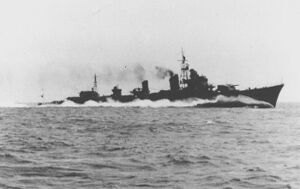Engineering:Japanese destroyer Shimakaze (1942)
 Shimakaze underway.
| |
| History | |
|---|---|
| Name: | Shimakaze (島風) (Island Wind) |
| Builder: | Maizuru Naval Arsenal |
| Laid down: | 8 August 1941 |
| Launched: | 18 July 1942 |
| Commissioned: | 10 May 1943 |
| Struck: | 10 January 1945 |
| Fate: | Sunk in the Battle of Ormoc Bay near Cebu, Philippines, 11 November 1944 |
| General characteristics | |
| Class and type: | Shimakaze |
| Type: | Destroyer |
| Displacement: | |
| Length: | |
| Beam: | 11.2 m (36 ft 9 in) |
| Draft: | 4.15 m (13 ft 7 in)[3] |
| Installed power: | 75,000 shp (56,000 kW) |
| Propulsion: |
|
| Speed: | 40.9 kn (75.7 km/h; 47.1 mph) |
| Range: | 6,000 nmi (11,000 km; 6,900 mi) at 18 kn (33 km/h; 21 mph) |
| Complement: | 267 (May 1943) |
| Armament: |
|
Shimakaze (島風) (Island Wind) was an experimental destroyer of the Imperial Japanese Navy during World War II. She was armed with six 127 mm (5.0 in) dual-purpose guns and conventional anti-aircraft and anti-submarine weaponry. More importantly, she was the only Japanese destroyer to be armed with 15 torpedo tubes, each capable of firing the deadly 610 mm (24 in) Type 93 "Long Lance" torpedo. The ship was a testbed for an enormously powerful, high-temperature, high-pressure steam turbine that was able to develop 79,240 shp (59,090 kW). This made her one of the fastest destroyers in the world: her designed speed was 39 kn (72 km/h; 45 mph), but on trials she made 40.9 kn (75.7 km/h; 47.1 mph).
Building
Ordered in 1939 under the 4th Naval Armaments Supplement Programme, Shimakaze was laid down in Maizuru Naval Arsenal in August 1941 and completed on 10 May 1943.
Japan had intended to lay down 16 similar destroyers, with long-term plans—the 5th Naval Armaments Supplement Programme—for a total of 32 to equip four destroyer squadrons, but a lack of industrial capacity prevented them from being realized.
Service history
In June 1943, Shimakaze participated in the evacuation of Japanese troops from Kiska Island towards the end of the Aleutian Islands campaign. She was present in June 1944 at the Battle of the Philippine Sea. In October 1944, the destroyer was present at the Battle of Leyte Gulf, although she played no role in the battle except for picking up survivors from the sunken battleship Musashi. While serving as the flagship of Destroyer Squadron 2 under the command of Rear Admiral Mikio Hayakawa, she was attacked and sunk by American aircraft from Task Force 38 on 11 November 1944 during the Battle of Ormoc Bay.
Speed test
Shimakaze was powered with an experimental steam turbine — which made construction of sister ships virtually impossible[citation needed] – during a speed test on 7 April 1943, she was clocked at 40.90 kn (75.75 km/h; 47.07 mph) with an engine output of 79,240 shp (59,090 kW).
Wreck
Shimakaze was discovered by a Paul Allen-led expedition aboard RV Petrel in Ormoc Bay on December 1, 2017, 715 ft (218 m) below the surface. She was a mangled wreck but the three quintuple torpedo tube launchers confirmed her identity.[7] Photographs from the wreck also debunked the assertion that she had one of her turrets removed in an early 1944 refit.[8]
Ships in class
| Ship | Ship No. | Fate |
|---|---|---|
| Shimakaze (島風) | 125 | Stricken from record on 10 January 1945 |
| 16 destroyers (Super Shimakaze) |
733-748 | Cancelled and re-planned on 30 June 1942 to: 8 × Yūgumo class (Ship # 5041-5048) 7 × Super Akizuki class (Ship # 5077-5083) |
References
- ↑ Ford, Roger (2001) The Encyclopedia of Ships, pg. 403-404. Amber Books, London. ISBN:978-1-905704-43-9
- ↑ Ford, Roger (2001) The Encyclopedia of Ships, pg. 403-404. Amber Books, London. ISBN:978-1-905704-43-9
- ↑ Ford, Roger (2001) The Encyclopedia of Ships, pg. 403-404. Amber Books, London. ISBN:978-1-905704-43-9
- ↑ Ford, Roger (2001) The Encyclopedia of Ships, pg. 403-404. Amber Books, London. ISBN:978-1-905704-43-9
- ↑ "RV Petrel" (in en). https://www.facebook.com/pg/rvpetrel/photos/?tab=album&album_id=1547103538658455.
- ↑ Ford, Roger (2001) The Encyclopedia of Ships, pg. 403-404. Amber Books, London. ISBN:978-1-905704-43-9
- ↑ "RV Petrel" (in en). https://www.facebook.com/pg/rvpetrel/photos/?tab=album&album_id=1547103538658455.
- ↑ "RV Petrel" (in en). https://www.facebook.com/rvpetrel/photos/a.1547103538658455.1073741836.1510752248960251/1547103598658449/?type=3&theater.
Sources
- Whitley, M.J. (1988). Destroyers of World War 2. Cassell Publishing. ISBN 1-85409-521-8.
- Collection of writings by Sizuo Fukui Vol.5, Stories of Japanese Destroyers, Kōjinsha (Japan) 1993, ISBN:4-7698-0611-6
- The Maru Special, Japanese Naval Vessels No.41 Japanese Destroyers I, Ushio Shobō (Japan), July 1980, Book code 68343-42
- Ford, Roger; Gibbons, Tony; Hewson, Rob; Jackson, Bob; Ross, David (2001). The Encyclopedia of Ships. London: Amber Books, Ltd.. pp. 403–404. ISBN 978-1-905704-43-9.
External links
[ ⚑ ] 10°50′N 124°35′E / 10.833°N 124.583°E

